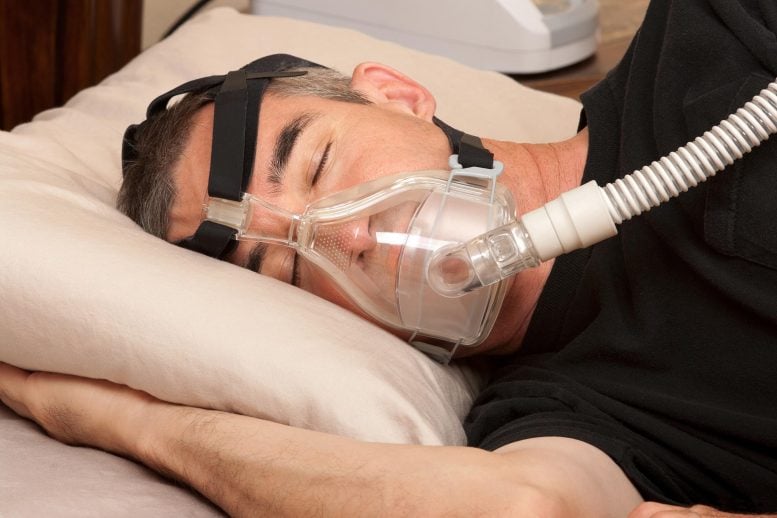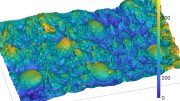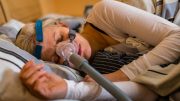
Researchers have discovered that improvements in sleep apnea symptoms appear to be linked to the reduction of fat in one unexpected body part — the tongue.
Penn Medicine study suggests the tongue could be a new target for treating the common sleep disorder.
Losing weight is an effective treatment for Obstructive Sleep Apnea (OSA), but why exactly this is the case has remained unclear. Now, researchers in the Perelman School of Medicine at the University of Pennsylvania have discovered that improvements in sleep apnea symptoms appear to be linked to the reduction of fat in one unexpected body part — the tongue.
Using magnetic resonance imaging (MRI) to measure the effect of weight loss on the upper airway in obese patients, researchers found that reducing tongue fat is a primary factor in lessening the severity of OSA. The findings were published today (January 10, 2020) in the American Journal of Respiratory and Critical Care Medicine.
“Most clinicians, and even experts in the sleep apnea world, have not typically focused on fat in the tongue for treating sleep apnea,” said Richard Schwab, MD, chief of Sleep Medicine. “Now that we know tongue fat is a risk factor and that sleep apnea improves when tongue fat is reduced, we have established a unique therapeutic target that we’ve never had before.”
Twenty-two million Americans suffer from sleep apnea, a serious health condition in which breathing repeatedly stops and starts, causing patients to wake up randomly throughout their sleep cycles. The condition, which is usually marked by loud snoring, can increase your risk for high blood pressure and stroke. While obesity is the primary risk factor for developing sleep apnea, there are other causes, such as having large tonsils or a recessed jaw. CPAP (continuous positive airway pressure) machines improve sleep apnea in about 75 percent of patients, studies suggest, but for the other 25 percent — those who may have trouble tolerating the machine — alternative treatment options, such as oral appliances or upper airway surgery, are more complicated.
“Now that we know tongue fat is a risk factor and that sleep apnea improves when tongue fat is reduced, we have established a unique therapeutic target that we’ve never had before.” — Richard Schwab, MD, chief of Sleep Medicine
A 2014 study led by Schwab compared obese patients with and without sleep apnea, and found that the participants with the condition had significantly larger tongues and a higher percentage of tongue fat when compared to those without sleep apnea. The researchers next step was to determine if reducing tongue fat would improve symptoms and to further examine cause and effect.
The new study included 67 participants with mild to severe obstructive sleep apnea who were obese — those with a body mass index greater than 30.0. Through diet or weight loss surgery, the patients lost nearly 10 percent of their body weight, on average, over six months. Overall, the participants’ sleep apnea scores improved by 31 percent after the weight loss intervention, as measured by a sleep study.
Before and after the weight loss intervention, the study participants underwent MRI scans to both their pharynx as well as their abdomens. Then, using a statistical analysis, the research team quantified changes between overall weight loss and reductions to the volumes of the upper airway structures to determine which structures led to the improvement in sleep apnea. The team found that a reduction in tongue fat volume was the primary link between weight loss and sleep apnea improvement.

CPAP machines improve sleep apnea in about 75 percent of patients, studies suggest, but for the other 25 percent — those who may have trouble tolerating the machine — alternative treatment options, such as oral appliances or upper airway surgery, are more complicated.
The study also found that weight loss resulted in reduced pterygoid (a jaw muscle that controls chewing) and pharyngeal lateral wall (muscles on the sides of the airway) volumes. Both these changes also improved sleep apnea, but not to the same extent as the reduction in tongue fat.
The authors believe that tongue fat is a potential new therapeutic target for improving sleep apnea. They suggest that future studies could be designed to explore whether certain low-fat diets are better than others in reducing tongue fat and whether cold therapies — like those used to reduce stomach fat — might be applied to reducing tongue fat. However, Schwab notes, these types of interventions have not yet been tested.
Schwab’s team is also examining new interventions and other risk factors for sleep apnea, including whether some patients who are not obese but who have “fatty” tongues could be predisposed to sleep apnea, but are less likely to be diagnosed.
In a recent related study, Schwab found that ethnicity may also play a role in sleep apnea severity. His research team compared the upper airway anatomy of Chinese and Icelandic patients with sleep apnea, and found that, compared to Icelandic patients of similar age, gender, and symptoms, Chinese patients had smaller airways and soft tissues, but bigger soft palate volume with more bone restrictions. This means that Asian patients may generally be more at risk for severe sleep apnea symptoms. The bottom line, according to Schwab, is that all patients who suffer from snoring or sleepiness should be screened for sleep apnea, whether or not they appear to fall into the typical “high-risk” obese categories.
“Primary care doctors, and perhaps even dentists, should be asking about snoring and sleepiness in all patients, even those who have a normal body mass index, as, based on our data, they may also be at risk for sleep apnea,” Schwab said.
Reference: “Effect of Weight Loss on Upper Airway Anatomy and the Apnea Hypopnea Index: The Importance of Tongue Fat” by Stephen H. Wang, Brendan T Keenan, Andrew Wiemken, Yinyin Zang, Bethany Staley, David B. Sarwer, Drew A. Torigian, Noel Williams, Allan I Pack and Richard J Schwab, 10 January 2020, American Journal of Respiratory and Critical Care Medicine.
DOI: 10.1164/rccm.201903-0692OC
This study was supported by grants from the National Institutes of Health. Additional Penn authors include Stephen H. Wang, Brendan T. Keenan, Andrew Wiemken, Yinyin Zang, Bethany Staley, David B. Sarwer, Drew A Torigian, Noel Williams, and Allan I. Pack.









To reduce tongue fat one needs to give the tongue more excercise. One way to to do this would be to spend more time talking, as well as eating.
But, just as eating less rubbish helps reduce body fat, so perhaps talking less rubbish would help keep the tongue lean.
I am experience difficulty to breath while using CPAP. 5 years back i bought MAD from England Snoring society but it wasnt a complete solution for me then recently I bought a stop snoring solution for stretching tongue. That was also insufficient. If i can get a 2 in one device both for tongue&jaw it might be better for me. An OSA patient,thanks.